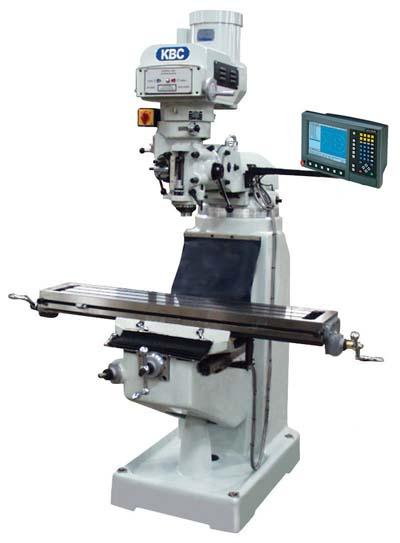
KBC Tools & Machinery added the KBC CNC Vertical Milling Machine with Acu-Rite CNC to its machinery lineup. Offered in four configurations (2- and 3-axis models in 9"x49" and 10"x50" table sizes), these packages combine a high-quality mill with an industry standard control for an entry level price.
Among many attractive features, the KBC Vertical Milling Machines sport a mechanical variable speed mill head that will reliably deliver full torque over the entire speed range. The hardened and ground table (available in two sizes) features precision hardened ground ways, ensuring the machine will stand up to years of usage. As well, a unique quill-release feature on the spindle drive allows for manual operation when CNC is unnecessary or unwanted.
When nothing but computerized accuracy will do, however, the included Acu-Rite CNC (made in the U.S.A.) is the optimal choice. Easy to learn and simple to use, the Acu-Rite is built with speed and convenience firmly in mind. An exceptionally clear full-color LCD display, 3D contouring capabilities, standardized menus, and components that have been manufactured and tested to withstand the harshest machine shop environments are all standard on the Acu-Rite MILLPWR Control system. Advanced features do not imply a steep learning curve however; the Acu-Rite has canned cycles for all regular milling and drilling jobs. Just fill in the blanks with your project specs and you are ready to roll with a program customized for your task.
Though you may not need it, support for both the KBC Mill and the Acu-Rite control is never far away. KBC always keeps parts for its mills in stock, while Acu-Rite handles inquiries concerning its U.S.-made CNCs through a well-organized North American support network. The proven reliability and ease of use associated with this package will allow you to get right down to work on equipment designed to meet the most demanding shop requirements.
Contact Details
Related Glossary Terms
- computer numerical control ( CNC)
computer numerical control ( CNC)
Microprocessor-based controller dedicated to a machine tool that permits the creation or modification of parts. Programmed numerical control activates the machine’s servos and spindle drives and controls the various machining operations. See DNC, direct numerical control; NC, numerical control.
- gang cutting ( milling)
gang cutting ( milling)
Machining with several cutters mounted on a single arbor, generally for simultaneous cutting.
- milling
milling
Machining operation in which metal or other material is removed by applying power to a rotating cutter. In vertical milling, the cutting tool is mounted vertically on the spindle. In horizontal milling, the cutting tool is mounted horizontally, either directly on the spindle or on an arbor. Horizontal milling is further broken down into conventional milling, where the cutter rotates opposite the direction of feed, or “up” into the workpiece; and climb milling, where the cutter rotates in the direction of feed, or “down” into the workpiece. Milling operations include plane or surface milling, endmilling, facemilling, angle milling, form milling and profiling.
- milling machine ( mill)
milling machine ( mill)
Runs endmills and arbor-mounted milling cutters. Features include a head with a spindle that drives the cutters; a column, knee and table that provide motion in the three Cartesian axes; and a base that supports the components and houses the cutting-fluid pump and reservoir. The work is mounted on the table and fed into the rotating cutter or endmill to accomplish the milling steps; vertical milling machines also feed endmills into the work by means of a spindle-mounted quill. Models range from small manual machines to big bed-type and duplex mills. All take one of three basic forms: vertical, horizontal or convertible horizontal/vertical. Vertical machines may be knee-type (the table is mounted on a knee that can be elevated) or bed-type (the table is securely supported and only moves horizontally). In general, horizontal machines are bigger and more powerful, while vertical machines are lighter but more versatile and easier to set up and operate.
- milling machine ( mill)2
milling machine ( mill)
Runs endmills and arbor-mounted milling cutters. Features include a head with a spindle that drives the cutters; a column, knee and table that provide motion in the three Cartesian axes; and a base that supports the components and houses the cutting-fluid pump and reservoir. The work is mounted on the table and fed into the rotating cutter or endmill to accomplish the milling steps; vertical milling machines also feed endmills into the work by means of a spindle-mounted quill. Models range from small manual machines to big bed-type and duplex mills. All take one of three basic forms: vertical, horizontal or convertible horizontal/vertical. Vertical machines may be knee-type (the table is mounted on a knee that can be elevated) or bed-type (the table is securely supported and only moves horizontally). In general, horizontal machines are bigger and more powerful, while vertical machines are lighter but more versatile and easier to set up and operate.
